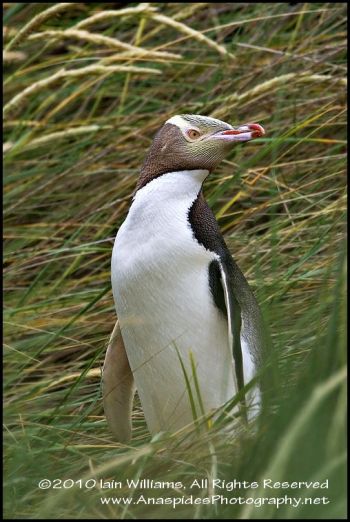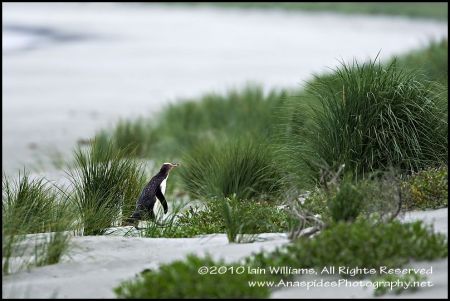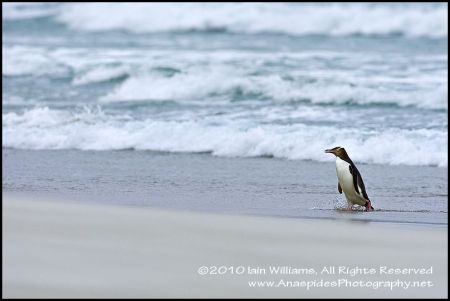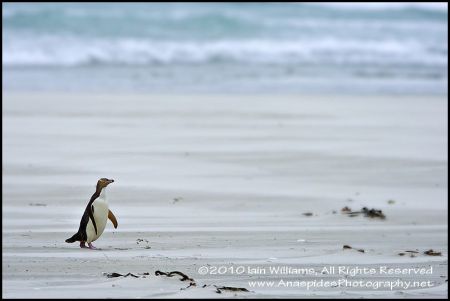Dancing with Hookers in New Zealand
 Friday, March 5, 2010 at 12:46PM
Friday, March 5, 2010 at 12:46PM 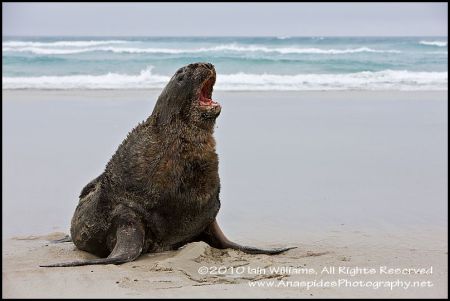 Although I’d been told roughly where the Hooker Sea Lion's haul out, I was doubtful I’d see one; they are quite uncommon. The beach I’d been directed to was long, isolated and ran parallel to a sand dune complex. At the headland I’d already photographed a few New Zealand fur seals and a couple of sooty oystercatchers; which were doing their utmost to hunker down within the loose sand to minimise the effects of a strong sea breeze that had been blowing for most of the afternoon.
Although I’d been told roughly where the Hooker Sea Lion's haul out, I was doubtful I’d see one; they are quite uncommon. The beach I’d been directed to was long, isolated and ran parallel to a sand dune complex. At the headland I’d already photographed a few New Zealand fur seals and a couple of sooty oystercatchers; which were doing their utmost to hunker down within the loose sand to minimise the effects of a strong sea breeze that had been blowing for most of the afternoon.
LEFT: A male Hooker Sea Lion. The head of a hooker looks completely different to others sea lions.
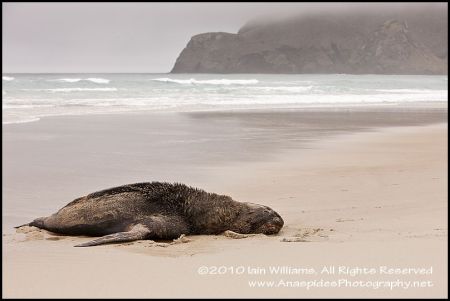 Looking farther along the beach from the headland I could see something that looked quite large and dark. Initially I thought it was a New Zealand fur seal, but this seal seemed too large for a fur seal. Hiking along the low tide mark, I was amazed to come across a massive animal in half moult with a face that looked less like a seal but more like something else – but what! I knew hookers can be quite large, especially the males, but this animal must have weighed in at close to 150 kilograms (around 300 pound). This did not in anyway look like the benign fur seals and California sea lions I was used to viewing.
Looking farther along the beach from the headland I could see something that looked quite large and dark. Initially I thought it was a New Zealand fur seal, but this seal seemed too large for a fur seal. Hiking along the low tide mark, I was amazed to come across a massive animal in half moult with a face that looked less like a seal but more like something else – but what! I knew hookers can be quite large, especially the males, but this animal must have weighed in at close to 150 kilograms (around 300 pound). This did not in anyway look like the benign fur seals and California sea lions I was used to viewing.
LEFT: Sleeping male Hooker Sea Lion on an isolated in New Zealand.
At first I was wary of aapproaching close to this behemoth as I knew looks can be deceiving; my past experience with seals had taught me that although they looked cumbersome, seals and sea lions are capable of very fast, yet short-lived turns of speed. But this old fellow seemed content to just lie on the beach in what appeared to a deep sleep – although I knew he wasn’t sleeping, as every now and again he would yawn, or 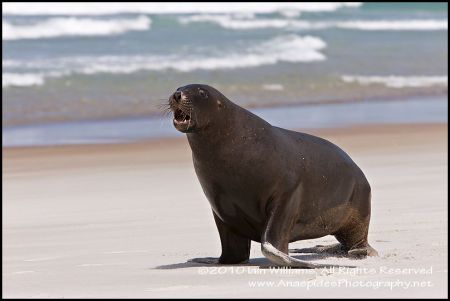 open an eye to dutifully watch that I maintained a reasonable distance.
open an eye to dutifully watch that I maintained a reasonable distance.
The jaws of the hooker looked formidable; large sharp teeth protruded from an exceptionally cavernous mouth. A small armada of flies swarmed around his jaws as he opened and closed them; I wasn’t close enough to smell his breath, but I can only imagine.
LEFT: A female Hooker Sea Lion walks to ward the male after exiting the ocean. The differences between male and females is very distinctive.
Rebecca and I spent probably close to 45 minutes with the sea lion and were about to depart when we noticed another seal a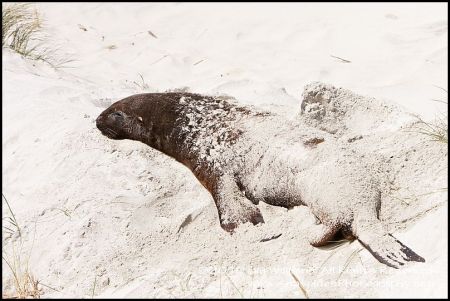 approaching from further down the beach. It soon was apparent that this was a female, and like all males his half sleep instantly evaporated as he sprang to life making himself look tall as he watched the female exit the surf and make her way towards him. After what appeared to be some affectionate nose touching and snorting, the two then about faced and marched off toward the surf to take to the sea.
approaching from further down the beach. It soon was apparent that this was a female, and like all males his half sleep instantly evaporated as he sprang to life making himself look tall as he watched the female exit the surf and make her way towards him. After what appeared to be some affectionate nose touching and snorting, the two then about faced and marched off toward the surf to take to the sea.
LEFT: A male Hooker Sea Lion sleeps in the sand dunes. Hokers cover themselves in sand to regulate ambient temperatures; the sand stops them getting sunburnt too!
HOOKER SEA LION FACTS
- SIZE: Male length 2 - 2.35 meters (6.5 - 7.7 feet)
- SIZE: Female length 1.6 - 2 meters (5.2 - 6.5 feet)
- WEIGHT: Male 300 - 450 kilograms (660 - 990 pound)
- WEIGHT: Female up to 160 kilograms (352 pounds)
- SEXUAL MATURITY: 3 -4 years with males breeding after 8 years
- LIFE EXPECTANCY: 18 - 23 years (females/males)
- CONSERVATION STATUS: Threatened (New Zealand marine Mammal Protection Act. Classified as vulnerable by IUCN Red List 2007
The Hooker's sea lion (Phocarctos hookeri) also known as the New Zealand Sea Lion, is one of the World's rarest and most endangered sea lions. They were extensively hunted for their hide and oil until hunting was banned in New Zealand in 1893. Today, the sea lion has been designated as a Threatened Species under New Zealand's Marine Mammals Protection Act and is listed as Vulnerable on the IUCN Red List.
BREEDING & FEEDING
Hooker Sea Lions breed almost exclusively on New Zealand's sub antarctic islands and haul out at a number of locations between Macquarie Island and the South Island of New Zealand. Their favoured haul out areas are sandy beaches, and often individuals can be found resting in depressions within sand dune complexes up to 2 kilometres inland.
Hooker Sea Lions are opportunistic feeders with a main diet of cephalopods, crabs, crayfish, and fish, however, fur seals and penguins have also been documented as prey. Similar to elephant seals they are excellent divers and sea lions often reach depths between 300 and 600 meters.
THREATS & CONSERVATION
The total world population of hookers was estimated to be between 12000 and 14000 individuals; however, in 1998 a mass mortality event occurred which drastically reduced their numbers. The reason for the mortality event is unknown, but it highlights the risk faced by a species that only breed at a few site worldwide.
If a problem were to occur at any particular site, such as introduction of a disease or another mass mortality event, then the loss of one breeding site would be cataclysmic with regard to species recruitment.
A more insidious threat to the sea lion is the fishing industries use of trawl nets to catch squid . Often Hooker Sea Lions will become entangled in the nets and drown as both the fishing fleet and the sea lions are targeting the same prey – squid. This said, the fishing industry is cognisant of the bi-catch problem and has introduced capture-release devices to many of their nets resulting in less sea lion deaths.



